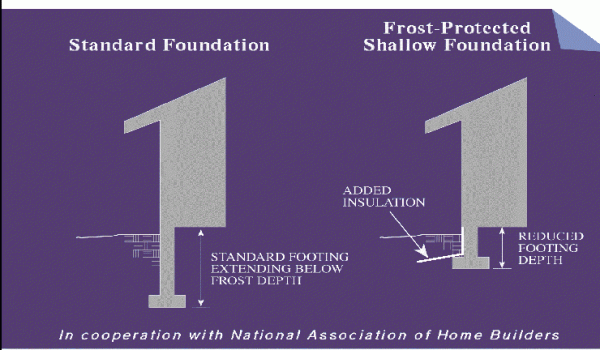A frost protected shallow foundation (FPSF) is a practical alternative to deeper, more-costly foundations in cold regions with seasonal ground freezing and the potential for frost heave. An FPSF incorporates strategically placed insulation to raise the frost depth around a building, which allows for foundation depths as shallow as 16 inches even in the most severe climates (see Figure 1). This method has been used extensively in Nordic countries, where over one million FPSF homes have been constructed successfully over the last 40 years. Scandinavia considers FPSF a standard practice for residential buildings.
The Air-Freezing Index (AFI) is a common metric for determining the freezing severity of the winter season. AFI values represent the seasonal magnitude and duration of below-freezing air and can be used to estimate the maximum depth of frost penetration, which is useful for determining the depth of shallow foundation construction.
An accurate estimate of maximum soil frost depth is one important factor in construction costs and building foundations. AFI data and maps have been calculated using temperature data from the 1951–1980 and 1981–2010 Climate Normals.
Cautionary Note When Using AFI Values: Topographic variability, proximity to bodies of water, and urban heat effects should be considered when using these data. For those locations or if the planned construction site is not located nearby a station that has AFI data, using a combination of the AFI map and the most representative city(s) AFI value(s) is advisable.
Maps
Temperature data from 5,600 stations were used to interpolate the 100-year return period of the AFI for the continental United States. A total of 4984 stations (in blue) have calculated return period values for the 1981–2010 period, while the remaining stations (in red) indicate locations that were “too warm” to compute return period values.
- Distribution of stations from the 1981–2010 Normal Period
- Air-Freezing Index, Estimate of the 100-year Return Period, coterminous United States
Data Tables
The data table publication contains a station inventory and a list of stations with the specific 100-year return period value located in the far right column. Other columns in the table contain lesser return periods and are listed for comparison purposes or other applications. Use only the 100-year return period in this publication for FPSF. In addition, this AFI Readme file provides additional documentation on the AFI tables listed below.
Documentation
The publication below contains the methodology used to create the 100-year return period of the AFI for the 1981-2010 period.
Maps
These map analyses use data from 3,110 cities to interpolate the 100-year return period of the AFI for the continental United States, Alaska, Hawaii, and Puerto Rico. The data tables contain the actual 100-year return period AFI values for these cities.
- Air-Freezing Index, Estimate of the 100-year Return Period, United States
- Air-Freezing Index, Estimate of the 100-year Return Period, Alaska
- Air-Freezing Index, a Simplified Analysis of the 100-year Return Period
Data Tables
The data table publication contains a list of cities with the specific 100-year return period value located in the far right column. Other columns in the table contain lesser return periods and are listed for comparison purposes or other applications. Use only the 100-year return period in this publication for FPSF.
- Air-Freezing Index Return Periods and Associated Probabilities
- Air-Freezing Index Return Periods and Associated Probabilities Spreadsheet
- Air-Freezing Index Seasonal Data
- Air-Freezing Index Seasonal Data Spreadsheet
Documentation
The technical publication below contains the methodology used to create the 100-year return period of the AFI. Pages 8–11 provide an overview and sections on AFI data applications and a description of the AFI return period estimates. Pages 7–8 contain references that supported this work.
Air-Freezing Index Statistics for the United States (DSI9712D)
The National Association of Home Builders provides additional information on FPSF that describes this technology in more detail on their website. In 2001, the American Society of Civil Engineers and the International Code Council approved ASCE 32-01 for reference in the 2002 addendums and 2003 editions of the International Building Code and International Residential Code. The standards committee consisted of individuals from many backgrounds including consulting engineering, research, testing, manufacturing, construction, education, government, and private practice.


